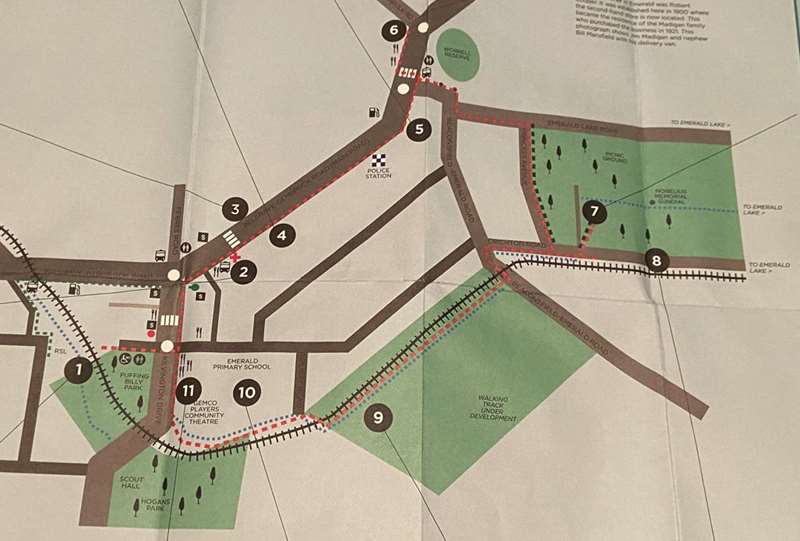Emerald Heritage Walk (Emerald)

The Emerald Heritage Walk celebrates and recognises the local history of Emerald.
The self-guided map includes a historical timeline and stories about eleven buildings around Emerald. The A3 size map includes a legend that details the facilities, amenities and places to eat and can be commenced at any point on the trail.
Maps are available to download on your mobile and are available from the Emerald Museum, Emerald Community House, Cardinia Hills Hub, Puffing Billy Railway stations, Emerald Library and selected cafes.
Download the map of the trail.
The walk takes approximately 50 minutes and takes in great views of Emerald and surrounds.
Route Map

Key to Heritage Places
1. EMERALD STATION
-embed04.jpg)
Puffing Billy Railway. 1900 saw the first narrow gauge train, Puffing Billy, run from Ferntree Gully to Gembrook. Carl Axel Nobelius successfully lobbied the government to install the line to service the import and export of plants and trees from his nursery. The Station was built in 1901 and later had a kiosk added to provide refreshments to travellers.
2. CHURCH OF CHRIST
Current Community House Hall. This early building, the former Church of Christ, was built in 1914 and two inaugural members were Mrs CL Nobelius and Mrs Jas. Legg who were both members of early pioneer families. It was used as an annex for State school children in the 1930s and 1940s. It is now the Emerald Community House Church Hall and has been restored to its former glory.
3. FIRST BABY HEALTH CENTRE
-embed01.jpg)
Current Infant Welfare Centre. In March 1940 the Baby Health Centre was officially opened, which is commemorated by a plaque that sits on the front of the building. This is one of Emerald's first brick buildings and is still in its original Art Deco style. It is unique for having operated continuously for its original purpose and in the same place for over seventy years.
4. FIRST PHARMACY
Mrs Meg Mickelborough established Emerald's first pharmacy here in this cottage on Belgrave-Gembrook Road, working from the front enclosed veranda of her home and using the kitchen as her dispensary.
5. FIRST POST OFFICE
Mail was first sorted from Andrews' Store, corner of Monbulk & Main Rds. The first official Post Office operated out of a private house here on Main Rd for ten years from 1910. It was then relocated to next to the Community House Hall.
6. FIRST BUTCHER
The first butcher in Emerald was Robert Couper. It was established here in 1900 where the second-hand store is now located. This became the residence of the Madigan family who purchased the business in 1921.
7. EMERALD MUSEUM NOBELIUS HERITAGE PARK
-embed02.jpg)
Set in the beautiful and historic Nobelius Heritage Park, Emerald Museum tells the story of Emerald's colourful history through displays of memorabilia, photographs and documents dating from early occupation to the present day. The Museum collection contains approximately 6,000 photographs, memorabilia, documentary records and family histories relevant to Emerald and surrounding districts.
This four and a half hectare Heritage Park was part of the world-famous Nobelius Nursery, established in 1886 by Swedish immigrant Carl Axel Nobelius, which once covered more than 650 hectares at its peak just before WWI. At this time the Nursery employed 80 people and was the largest exporter of fruit and ornamental trees in the Southern Hemisphere.
The Nursery operated under the business name of Gembrook Nurseries because Emerald was part of the Parish of Gembrook and is credited with being the single and most important factor in Emerald's early economic and social development.
The park is listed on the Victorian Heritage Register as a remnant of this historic enterprise, with several original and rare plantings remaining. Both the Emerald Museum and the Nobelius Heritage Park are managed by a volunteer committee under the authority of Cardinia Shire Council.
8. NOBELIUS SIDING & PACKING SHED
-embed03.jpg)
The volume of freight produced by Nobelius Nursery was so great that in 1904 Nobelius was granted land for a railway siding and packing shed here. Bare-rooted trees were packed into bundles and loaded onto the narrow gauge railway for transport to many parts of the world. The packing shed also served as an office and was the first building in Emerald to be connected to the telephone network.
9. SUNNYSIDE [LOOK OUT)
Notable landowner Alexander Crichton built this historic house, on Beaconsfield Road in the 1920s for a resident authoress. Subsequent owner and local butcher Jim Madigan, who used the land to hold his cattle before they were transported to the abattoirs, named the property 'Sunnyside'. The land was later used to cultivate potatoes until it was purchased by the State government as a community heritage landmark.
10. EMERALD STATE SCHOOL NO 3381
This is the site of Emerald School built in 1910 for the enrolment of 70 local children, it was constructed after a great deal of lobbying by parents who were dissatisfied with the temporary building located in Sherriff Rd that had a dirt floor. The original school opened in Avon Rd, Avonsleigh (then called East Emerald) in 1879, which was later replaced by the temporary building. This historic photograph was taken of the school children in the 1930s.
11. FIRST POLICE STATION
This building was the residence of the Emerald Township's first formal policeman - Constable William Rogers - from 1909. Note the small "lock-up" on the left rear side of the building where prisoners were held. During 1858-1859 only one policeman William Stuart was on the gold diggings. Records show that constable Patrick Moylette while on patrol from Dandenong police station, disappeared riding his horse to the Britannia gold fields. He was never found.
Photos:
Location
17 Kilvington Drive, Emerald 3782 Map
Web Links
→ The Best Family Activities in the Dandenong Ranges











